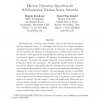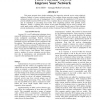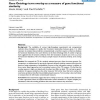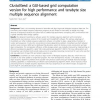653 search results - page 125 / 131 » Using common random numbers for indifference-zone selection |
ADHOC
2006
13 years 7 months ago
2006
Self-organization of wireless sensor networks, which involves network decomposition into connected clusters, is a challenging task because of the limited bandwidth and energy reso...
SIGMETRICS
2008
ACM
13 years 7 months ago
2008
ACM
We consider a wireless collision channel, shared by a finite number of mobile users who transmit to a common base station using a random access protocol. Mobiles are selfoptimizin...
LISA
2003
13 years 9 months ago
2003
This paper presents three simple techniques for improving network service using relatively unknown features of many existing networks. The resulting system provides greater reliab...
BMCBI
2008
13 years 7 months ago
2008
Background: The availability of various high-throughput experimental and computational methods allows biologists to rapidly infer functional relationships between genes. It is oft...
BMCBI
2010
13 years 7 months ago
2010
Background: There is an increasing demand to assemble and align large-scale biological sequence data sets. The commonly used multiple sequence alignment programs are still limited...




